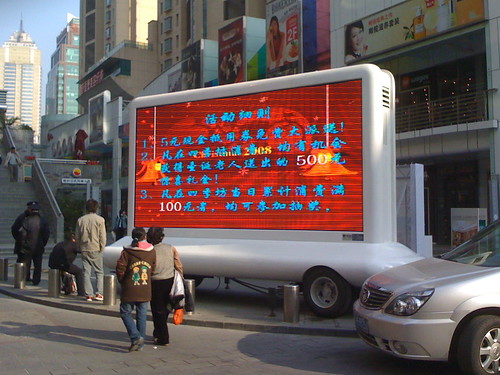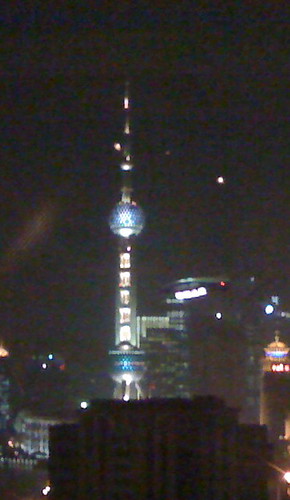Wherever you are in China you know you will get bombarded with advertising, but sometimes it gets a bit too much. The Bund in Shanghai, the waterfront on the Puxi site of town, is a good example of this. Just a few years ago it was a nice location to take some pictures of the Pudong skyline. But about 3 years ago two of the skyscrapers (first the Aurora tower and later the CitiBank tower) have both been converted in huge LCD screens. I hated it at first, but somehow I have gotten used to it – I could see them in the distance from my former apartment and after a while you sort of blank them out in your mind.
But what you cannot ignore are the LCD screen ships that started cruising along the Bund in 2006. It is an extreme case of horizon pollution: you cannot even see the horizon anymore because a 30 meter long LCD billboard is in between you and the scenic other side of the river. I vowed never to use a product or brand advertised on them, but too many brands are using this “new marketing opportunity” nowadays, so it’s become almost impossible.
 When you can put a LCD screen on a boat you can of course also put one behind a car, and that’s what some entrepreneurs are doing now as well. I wonder if these mobile LCD screens have caused any accidents so far. Or maybe drivers are so used to all advertising around them that they do not even notice them anymore? That happens me to me in taxi’s in Shanghai, where most have an LCD screen built into the front passenger seat, so you can happily watch commercials while being driven to your destination. I hardly notice the screen anymore. And if I do I turn off the sound and put a coat over it – problem solved.
When you can put a LCD screen on a boat you can of course also put one behind a car, and that’s what some entrepreneurs are doing now as well. I wonder if these mobile LCD screens have caused any accidents so far. Or maybe drivers are so used to all advertising around them that they do not even notice them anymore? That happens me to me in taxi’s in Shanghai, where most have an LCD screen built into the front passenger seat, so you can happily watch commercials while being driven to your destination. I hardly notice the screen anymore. And if I do I turn off the sound and put a coat over it – problem solved.
 But if you think LCD screens on buildings, cars and boats cannot be topped, you underestimate Chinese entrepreneurial creativity. A few days ago I was having a drink at the 24th floor bar at M1NT when I suddenly saw an LCD screen right in front of me outside the window. It took me a few seconds to figure out what it was, and then I realized it was a zeppellin with an LCD screen on it. I tried to take a picture, but the combination of taking a photo with an iPhone from a lighted bar while it’s pitch dark outside leads to sub-optimal results (and that’s a big understatement). Hopefully you can just make out the zeppelin in the middle of the picture, just to the right of the Oriental Pearl Tower.
But if you think LCD screens on buildings, cars and boats cannot be topped, you underestimate Chinese entrepreneurial creativity. A few days ago I was having a drink at the 24th floor bar at M1NT when I suddenly saw an LCD screen right in front of me outside the window. It took me a few seconds to figure out what it was, and then I realized it was a zeppellin with an LCD screen on it. I tried to take a picture, but the combination of taking a photo with an iPhone from a lighted bar while it’s pitch dark outside leads to sub-optimal results (and that’s a big understatement). Hopefully you can just make out the zeppelin in the middle of the picture, just to the right of the Oriental Pearl Tower.
Coincidentally, while writing this during my lunch break I took a glance at today’s Shanghai Daily and what headline do I see? “City to curb those ads on the move”. The city government has drawn up a series of regulation to restrict outdoor advertising on moving platforms, and these should be approved this month. That means that the ads on the skyscrapers may not go away, but the boats and aircraft will be a thing of the past very soon.
The boats “could affect cargo and passenger ships from clearly seeing navigation lights on the river”, according to the paper. For that reason they will not be allowed anymore between the Yangpu and Lupu bridge (which includes the downtown part along the Bund). Not sure why that would not be big issue on other parts of the river, but good to hear!
The environmental watchdog, the government organization in charge of these changes, will also include buses and taxis in their new regulation. Buses, for example, will only be allowed to carry advertising on a reduced space on their exterior. But because the environmental watchdog is not in charge of ads inside buses and taxis we will still have to endure the LCD screens inside the taxis.

You are right. I noticed this when I first went to Shanghai several years ago, and since then the LCD advertising has gotten almost out of control.
The main problem I have with those screens, is that they are used PURELY for advertising. In many other cities around the world, you have advertising, but it’s part of the full program, which also offers you news, weather, map, next station, etc. which makes it an added value to the AUDIENCE, and not just the advertiser (that’s how the ad becomes valuable).
But in Shanghai, in China, those are used JUST for advertising. In the metro, lcd screens ONLY show ads. If you wanna know the next station, tough luck. In the taxi, god forbid you could have news, or other useful info. Again, just ads.
I think that’s what makes it doubly hard to swallow.
picture of an advertizement blimp i recently took in xujiahui: http://www.flickr.com/photos/web2asia/3262417679/
scene from blade runner: http://antiadvertisingagency.com/wp-content/uploads/2008/05/snap059181.jpg
🙂